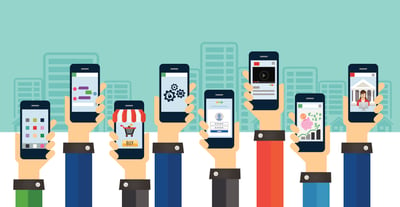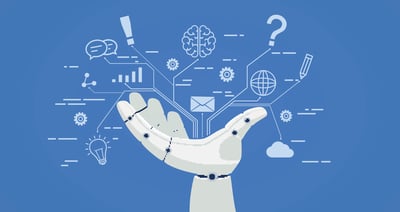August 21, 2019
 by Nanditha Vijayaraghavan / August 21, 2019
by Nanditha Vijayaraghavan / August 21, 2019
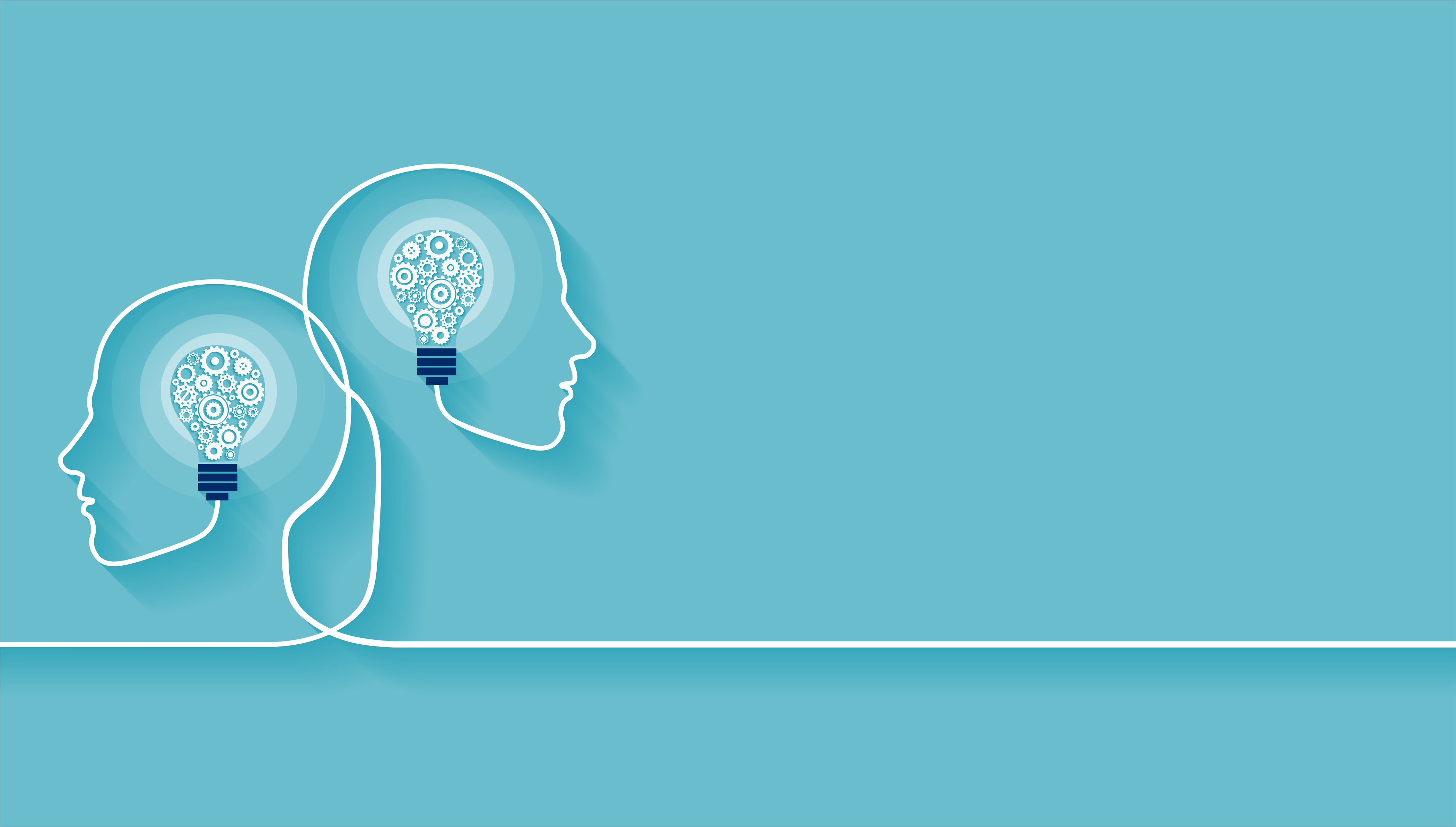
Ever wondered why some marketing ideas spread overnight while others disappear into thin air?
How do some products become ubiquitous, while others never gain traction? The answer is cognitive biases, of which nearly 200 rule our everyday thinking.
Cognitive biases are systematic errors in thinking that affect human judgments and decision-making tasks. This means that the human mind may misremember an event or situation based on biased thinking embedded in their minds.
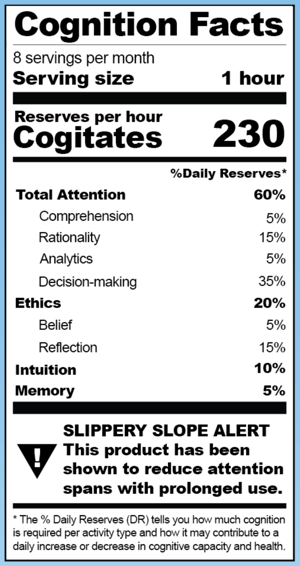
At any given minute, our brain is carrying out trillions of mental processes and is constantly looking for rules of thumb to apply across various situations to ease the burden of execution.
These rules are particularly useful while making complex decisions and judgements. Often in an attempt to simplify the execution process, our brain takes mental shortcuts leading us down the wrong path.
The failure to think clearly, or what some experts call “cognitive error,” is a systematic deviation from logic.
These are not mere occasional errors in judgement but rather routine mistakes, barriers to logic that we meet time and again, repeating patterns through generations.
Label image courtesy of Mickey McManus
The concept of “cognitive bias” was first introduced in the 1970s by social scientists Amos Tversky and Daniel Kahneman.
"A reliable way to make people believe in falsehoods is frequent repetition, because familiarity is not easily distinguished from truth. Authoritarian institutions and marketers have always known this fact."
- Daniel Kahneman
Consumer power has become a cliche of modern consumer culture. Today’s average consumer is radically different in characteristics and more importantly, behavior, compared to those even a few years ago.
As marketers, we are almost always doing two things:
However, with more layers of technology between us, we have less insight on what makes consumers choose one brand/product/service over another, what compels them to stay loyal to one brand and what drives them to do repeat business with that brand.
“Businessmen will eventually realize that customers are merely bundles of mental states and that the mind is a mechanism that we can affect with the same exactitude with which we control a machine in a factory.”
- Hugo Münsterberg
If you look closely at any great piece of marketing out there today, you'll find a behavioral principle from decision science lurking inside it. Some of the high-performing marketing content and campaigns on the internet today have hooks that appeal directly to the consumer’s mind, one way or another.
Applying the understanding of cognitive biases can dramatically transform the way marketers sell today and empower them to create great content, attract more buyers and drive higher conversions.
Buster Benson, Marketing Manager at Slack, attempted to simplify this for the rest of us marketers.
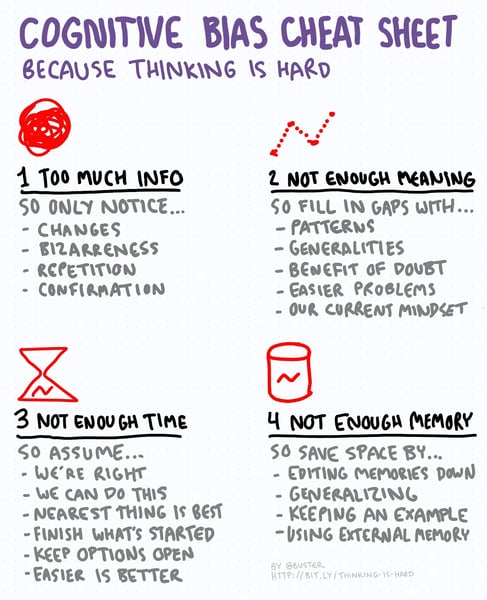 Graphic courtesy of Buster Benson and John Manoogian III
Graphic courtesy of Buster Benson and John Manoogian III
Organizing the 175 known biases into a giant codex with help from illustrations by John Manoogian III, Benson identified four key qualities or “conundrums” that limit a consumer’s thinking and decision-making.
| 1. There’s too much information available today for a consumer to process it all. |
| 2. To make raw information meaningful, consumers will have to connect the dots between the limited information they have and the accumulation of beliefs from their previous experiences. |
| 3. There isn’t enough time in their day to fully analyze all possibilities in order to make the right decisions and/or take the right actions. |
| 4. There’s simply not enough space in their brains to store all the raw information, experiential details and past decisions taken. |
Great marketing campaigns are great because they are thoughtfully designed to convert buyers by guiding them through a decision-making process with targeted and decisive messaging. It’s about understanding how people’s minds work and presenting your brand in the most effective way – something that’s increasingly difficult in a competitive online market.
Marketers can leverage the understanding of cognitive biases to create better user experiences, boost conversion rates, retain more of their customers and ensure they’re happy to keep doing business with their brand.
“When in doubt, assume that people will act according to their current irrational urges, ignoring information that runs counter to their beliefs, trading long-term for short-term benefits and most of all, being influenced by the culture they identify with.”
- Seth Godin
How much do first impressions matter? A great deal for the modern consumer, it turns out.
The one thing that marketers must remember while selling to today’s tech-savvy generation is that they are about everything instant: instant information, instant communication and instant gratification. This naturally implies that they want easy access to information, crave simplicity, and are highly impatient.
Making that great first impression with your brand then becomes a critical factor for them to stay on your website and spend time understanding and exploring their options of doing business with you.
Here’s where anchoring bias steps in. This cognitive bias is one in which the first bit of information a consumer receives becomes an anchor and all future evaluations are based on that anchor piece of information.
|
Related: Want to learn more about other biases? Check out this rundown of unconscious bias and how it affects your day-to-day. |
Kahneman, in a video interview with Inc. magazine, claims that the anchoring effect routinely happens “everywhere” and calls it “one of the most robust phenomena in cognitive psychology.”
A big price drop on a trending product or a massive clearance sale announcement is a classic example of this kind of bias.
Here’s how marketers can use the effect of their consumer’s anchoring bias to their advantage:
Refine your landing pages, product pages and other focused campaign pages to hone the emphasis to one standout feature or USP. That’s the anchor your consumers will remember your brand for and will convert the right visitor into a customer.
Apple perfectly uses its audience’s anchoring bias to design product pages and market the first or primary information that has the greatest impact upon a visitor’s subsequent decisions.

Design a tiered pricing structure on your pricing page to give buyers a frame of reference and guide them to a specific package/plan you’d like them to choose.
Xero does this well by drawing attention to its most expensive package, thus making it the visitor's price "anchor" and its other packages look more affordable in comparison.
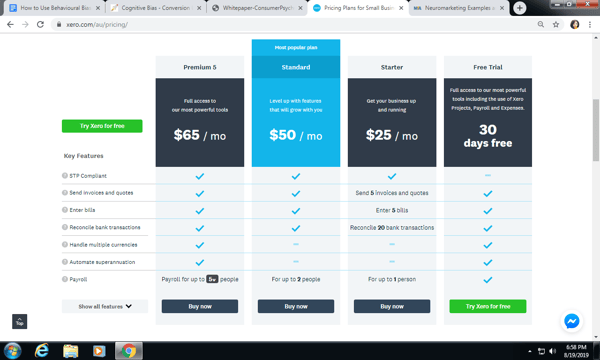
The modern consumer is part of a social-first generation that places big bets on high-value online interactions and affirmations. With 70% of millennials basing their potential purchase decisions on recommendations from friends and family, it is but imperative for marketers to understand this behavioural bias and sell to their audience accordingly.

But today’s consumers are not just seeking social proof for purchase decisions but also to discover new brands and products that will allow them to fit in with their peer groups. Additionally, if your brand stands for something more than just landing customers, then they will love you and most definitely do business with you.
Research shows that 37% of millennial consumers are willing to purchase a product or service that supports a cause they believe in, even if it means paying extra.
Here’s how marketers can use this bias to their advantage:
With trust and authenticity taking center stage for the new-age consumer, marketers should look to move away from traditional “celebrity/expert” influencers to a focused group of micro-influencers and create a strong social proof of their brand.
Start by identifying those micro-influencers, people in social communities that your consumers perceive to be “like them” and who are willing to share special offers with their network of friends, family and followers.
Glossier nails this one.
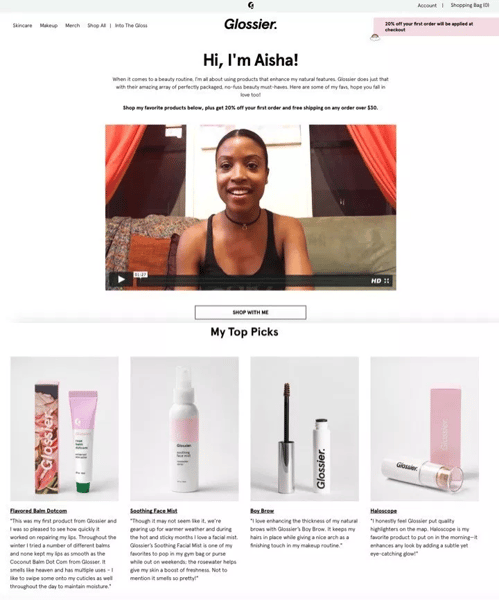
Stemming from their need for authenticity, modern consumers want to be engaged in human-centred campaigns that give them a sense of purpose towards the brand and the community at large.
|
TIP: Get started on the same path by discovering the highest-rated influencer marketing software solutions for your needs. |
Toms also gets it right and lives by its motto, One for One. For every shoe purchased, Toms gives a new pair to a child in need in another country.
To date, the company has donated more than 35 million pairs of shoes in 60 countries. Likewise, for every pair of glasses purchased, Toms helps restore the sight of a person in need. And for every bag of coffee purchased, Toms provides a week of clean water for someone in need.
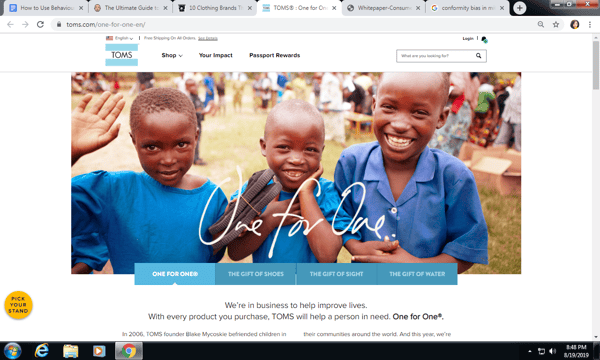
The next generation is transcending a consumer-grade expectation into their jobs, buying process, and purchase decisions. What does this mean for marketers? The need to shift the messaging and positioning focus from a thin slice of the customer’s rational, conscious brain into the massive opportunity that stems from their emotional, subsconscious needs.
Keep your customers top-of-mind by reviewing the top 101 customer service statistics to see where and how to improve your marketing tactics.
Nanditha is a Growth Marketer at Dixa who is passionate about how storytelling and targeted messaging create business-changing content. She helps purpose-driven businesses increase brand awareness, generate leads, and acquire new customers. She is equally passionate about building communities that nurture and incubate world-changing ideas.
Even those of us who were around in the time before smartphones have trouble imagining life...
 by Emily Coates
by Emily Coates
AI is taking over the world of client experience.
 by Emily Smith
by Emily Smith
Solutions often meet us at intersections.
 by Nanditha Vijayaraghavan
by Nanditha Vijayaraghavan
Even those of us who were around in the time before smartphones have trouble imagining life...
 by Emily Coates
by Emily Coates
AI is taking over the world of client experience.
 by Emily Smith
by Emily Smith
